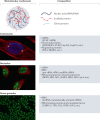Modulating biomolecular condensates: a novel approach to drug discovery
- PMID: 35974095
- PMCID: PMC9380678
- DOI: 10.1038/s41573-022-00505-4
Modulating biomolecular condensates: a novel approach to drug discovery
Abstract
In the past decade, membraneless assemblies known as biomolecular condensates have been reported to play key roles in many cellular functions by compartmentalizing specific proteins and nucleic acids in subcellular environments with distinct properties. Furthermore, growing evidence supports the view that biomolecular condensates often form by phase separation, in which a single-phase system demixes into a two-phase system consisting of a condensed phase and a dilute phase of particular biomolecules. Emerging understanding of condensate function in normal and aberrant cellular states, and of the mechanisms of condensate formation, is providing new insights into human disease and revealing novel therapeutic opportunities. In this Perspective, we propose that such insights could enable a previously unexplored drug discovery approach based on identifying condensate-modifying therapeutics (c-mods), and we discuss the strategies, techniques and challenges involved.
© 2022. Springer Nature Limited.
Conflict of interest statement
All authors are employees or board members of Dewpoint Therapeutics, a drug discovery company that studies condensates, and have a financial stake in the company.
Figures




References
-
- Heilbrunn LV. The colloid chemistry of protoplasm. Am. J. Physiol. 1923;63:481–498. doi: 10.1152/ajplegacy.1923.64.3.481. - DOI
-
- Oparin, A. I. The Origin of Life (Foreign Language Publishing House, 1936).
Publication types
MeSH terms
Substances
LinkOut - more resources
Full Text Sources
Other Literature Sources
Miscellaneous

